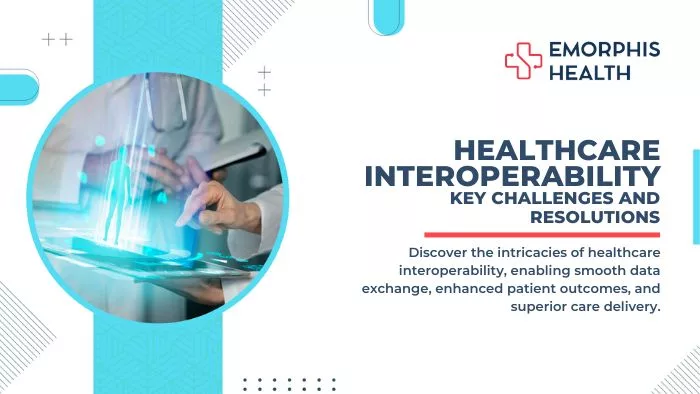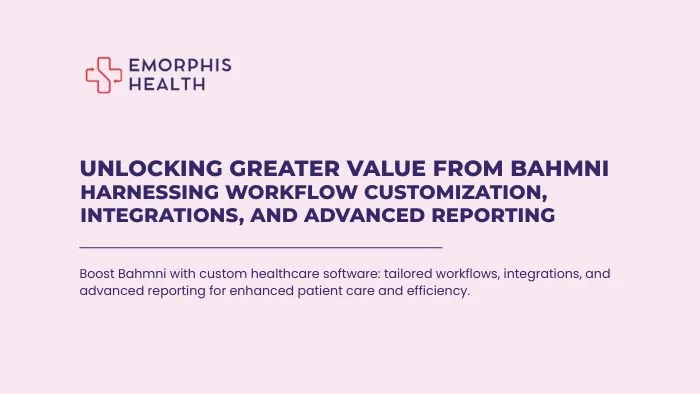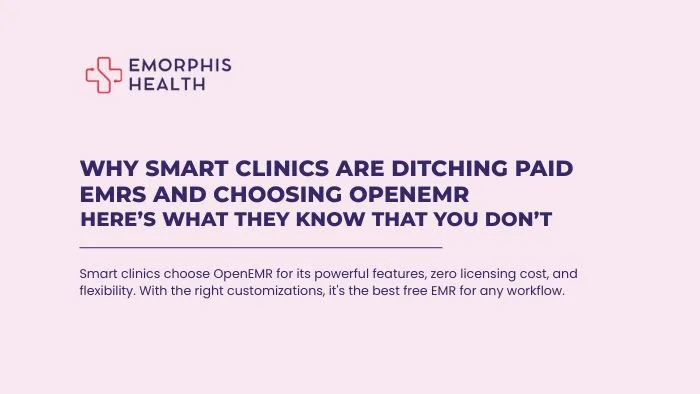Key Challenges in Achieving Healthcare Interoperability
See Contents
- 1 Key Challenges in Achieving Healthcare Interoperability
- 2 Resolutions for Healthcare Interoperability
- 3 Overcoming Financial Barriers to Interoperability
- 4 Case Studies and Success Stories of Healthcare Interoperability
- 5 Predictions for the Future of Interoperability in Healthcare
- 6 Recommendations for Healthcare Stakeholders
- 7 Conclusion
1. Data Standards and Formats
One of the primary challenges in achieving healthcare interoperability is the lack of standardized data formats and terminologies. Different healthcare systems and organizations often use varied data structures and coding systems. Moreover, making it difficult to exchange and interpret information accurately.
For instance, one healthcare system may store lab results using a specific coding standard. Also, another system might use a different one. Without common data standards, translating and mapping data between these systems becomes complex and error-prone. This is leading to data inconsistencies and potential patient safety risks.
To address this challenge, healthcare organizations and governing bodies need to adopt and adhere to widely accepted data standards, such as HL7 (Health Level Seven) and FHIR (Fast Healthcare Interoperability Resources). Embracing these standards ensures that data is uniformly formatted, facilitating seamless data exchange and reducing interoperability barriers.
2. Privacy and Security Concerns
Interoperability in healthcare raises significant privacy and security concerns, as it involves the exchange of sensitive patient information between various systems and stakeholders. Ensuring the confidentiality and integrity of patient data is paramount to maintaining public trust in healthcare systems.
Healthcare providers and organizations must comply with stringent data protection regulations, such as the Health Insurance Portability and Accountability Act (HIPAA) in the United States. These regulations mandate the implementation of robust security measures to safeguard patient data during its exchange and storage.
Additionally, technologies like blockchain are gaining traction for enhancing the security of healthcare data exchange. Blockchain’s decentralized and immutable nature provides an added layer of protection against unauthorized access and tampering with patient records.
3. Data Governance and Ownership
Establishing clear data governance policies and defining data ownership are critical challenges in healthcare interoperability. The question of who owns and controls patient data can vary depending on the healthcare system, jurisdiction, and data source.
Data governance frameworks must address issues related to data access, sharing permissions, data retention, and data disposal to ensure ethical and legal use of patient information. Collaborative efforts between healthcare providers, policymakers, and patient advocacy groups are essential to establish comprehensive data governance guidelines.
Interoperability also requires trust and transparency among healthcare organizations sharing patient data. Developing agreements and protocols for data sharing, including data use agreements (DUAs) and business associate agreements (BAAs), helps clarify responsibilities and expectations.
4. Technical Barriers and Legacy Systems
Technical challenges often hinder the implementation of interoperability solutions. Numerous healthcare systems still depend on outdated technologies that lack interoperability as a fundamental design feature. Integrating these systems with modern, interoperable solutions can be complex and costly.
Adopting Application Programming Interfaces (APIs) and other standardized integration techniques can help bridge the gap between legacy systems and newer, interoperable platforms. APIs enable secure and standardized data exchange between different applications, facilitating interoperability in a more cost-effective manner.
Moreover, healthcare organizations need to consider the scalability and sustainability of interoperability solutions. As the volume of healthcare data continues to grow, interoperability systems must be capable of handling the increasing data load without compromising performance.
Check our Healthcare Case Studies.
Resolutions for Healthcare Interoperability
a. Establishing Interoperability Standards and Initiatives
One of the key resolutions to promote healthcare interoperability is the adoption and adherence to standardized data exchange protocols and initiatives. Organizations like HL7 and FHIR have been at the forefront of developing interoperability standards that enable seamless data exchange between healthcare systems and applications.
By embracing these standards, healthcare organizations can ensure that their systems are compatible with others in the ecosystem, facilitating data sharing and integration. Interoperability standards also reduce the complexity of data mapping and translation, making it easier for different systems to understand and interpret shared information accurately.
Furthermore, collaboration between different stakeholders in the healthcare industry is essential to establish nationwide or even global interoperability networks. Initiatives like CommonWell Health Alliance and Care Quality promote interoperability by connecting various health information exchange (HIE) networks, enabling data exchange across different regions and healthcare providers.
b. Embracing Cloud-Based Interoperability Solutions
Cloud computing offers a scalable and cost-effective approach to healthcare interoperability. By leveraging cloud-based platforms, healthcare organizations can store and process vast amounts of data securely while ensuring seamless data exchange between different systems.
Cloud-based solutions also facilitate real-time data access, enabling healthcare providers to access patient information from anywhere with an internet connection. This flexibility is especially valuable in emergency situations or when caring for patients in remote or underserved areas.
Moreover, cloud-based interoperability solutions can accommodate the needs of healthcare organizations of all sizes, from small clinics to large hospital networks. This democratization of interoperability enables even resource-constrained organizations to participate in data exchange initiatives.
c. Encouraging EHR Vendor Interoperability
Electronic Health Record (EHR) systems are the backbone of modern healthcare, and interoperability among different EHR vendors is crucial for seamless data exchange. However, vendor-specific data formats and closed ecosystems have historically hindered interoperability efforts.
Healthcare stakeholders, including policymakers and industry leaders, should advocate for open standards and APIs that enable interoperability between different EHR systems. Vendors who prioritize interoperability and data-sharing capabilities in their products can help promote a more connected and efficient healthcare ecosystem.
Additionally, policymakers can incentivize EHR vendors to prioritize interoperability by incorporating interoperability requirements into certification criteria. By aligning certification standards with interoperability goals, the industry can move toward a more interoperable and data-driven healthcare environment.
d. Fostering a Culture of Interoperability
Promoting interoperability goes beyond technical solutions; it requires fostering a culture of data sharing and collaboration among healthcare stakeholders. Healthcare providers, administrators, and IT professionals must recognize the value of interoperability and its potential to enhance patient care and outcomes.
Organizations can incentivize data sharing and interoperability initiatives by highlighting the positive impact on patient care, efficiency, and cost savings. Recognizing and rewarding efforts to achieve interoperability can encourage healthcare providers to actively participate in data exchange networks and share best practices.
Moreover, fostering a culture of interoperability involves educating healthcare professionals about the benefits and methods of data exchange. Training programs and workshops can help improve data literacy and technical proficiency among the workforce, enabling them to navigate interoperability challenges more effectively.
Now let us check in with more details on Healthcare Interoperability and its related challenges and its resolutions.
Overcoming Financial Barriers to Interoperability
While healthcare interoperability offers numerous benefits, implementing interoperable solutions can pose financial challenges for healthcare organizations. Overcoming these barriers is essential to ensure that all healthcare stakeholders can participate in data exchange and fully leverage the advantages of interoperability. Here are some strategies to address financial barriers:
1. Streamlining Implementation Costs
Incentive Programs: Governments and insurance providers can offer financial incentives or reimbursements to healthcare organizations that invest in interoperable systems. These programs can help offset the initial implementation costs and encourage widespread adoption.
Group Purchasing Organizations (GPOs): Healthcare providers can collaborate through GPOs to negotiate favorable pricing and terms for interoperable solutions. GPOs leverage the collective purchasing power of multiple organizations, resulting in cost savings for all participants.
Cloud-Based Solutions: Cloud-based interoperable platforms can offer cost-effective solutions compared to traditional on-premises systems. By using cloud services, healthcare organizations can reduce hardware and maintenance expenses while benefiting from scalable and secure data storage.
2. Addressing Maintenance and Support Costs
Vendor Collaboration: Healthcare IT vendors can collaborate with healthcare organizations to provide cost-effective support and maintenance agreements. Vendors can offer tiered support packages tailored to the specific needs and budgets of different healthcare providers.
Shared Maintenance Agreements: In regional or community health systems, healthcare organizations can enter shared maintenance agreements for interoperable systems. Pooling resources can help distribute the ongoing maintenance costs among multiple participants, making it more manageable for individual organizations.
Public-Private Partnerships: Governments and private organizations can form partnerships to support the maintenance and continuous development of interoperable platforms. Public-private collaborations can secure funding and expertise to sustain and improve interoperability initiatives.
3. Leveraging Interoperability for Cost Savings
Reducing Redundancy: Interoperability helps reduce redundant medical tests and procedures by facilitating access to a patient’s comprehensive medical history. This leads to cost savings for both healthcare providers and patients.
Enhancing Care Coordination: Improved care coordination through interoperability can prevent hospital readmissions and complications, resulting in cost reductions for healthcare organizations.
Efficient Resource Utilization: Interoperable data exchange enables more efficient utilization of healthcare resources. Healthcare providers can allocate resources more effectively based on real-time patient data and community health needs.
4. Collaboration and Advocacy
Industry Collaboration: Healthcare organizations, IT vendors, policymakers, and patient advocacy groups must collaborate to address financial barriers to interoperability. Joint efforts can identify innovative funding models and resource-sharing opportunities.
Advocacy for Interoperability Funding: Stakeholders should advocate for increased funding for healthcare interoperability at the regional, national, and international levels. This can drive investments in research, infrastructure, and workforce training to support interoperability initiatives.
Public Awareness Campaigns: Educating the public about the benefits of interoperability can foster support for funding initiatives. Informed patients can advocate for interoperable solutions and encourage healthcare providers to invest in data exchange platforms.
Check the detailed article on Interoperability in Healthcare: Top Benefits and Future Trends
Case Studies and Success Stories of Healthcare Interoperability
To gain a deeper understanding of the real-world impact of healthcare interoperability, let’s explore some case studies and success stories of organizations that have successfully implemented interoperable solutions.
Case Study 1: The Healthcare Information Xchange of New York (Hixny)
Hixny is a health information exchange (HIE) based in New York that facilitates interoperability among various healthcare providers, hospitals, and insurers in the region. Through its secure data exchange platform, Hixny enables healthcare organizations to share patient data in real time, improving care coordination and patient outcomes.
In one notable case, Hixny played a crucial role in streamlining the care of a patient with multiple chronic conditions. The patient’s primary care physician, specialists, and care team were connected through Hixny’s interoperable network. This allowed them to access the patient’s complete medical history, test results, and medication lists.
With this comprehensive view of the patient’s health, the care team collaborated on a unified care plan, minimizing duplication of tests and treatments. The patient also had access to their health records through Hixny’s patient portal, empowering them to actively engage in their care and follow treatment recommendations.
As a result of this coordinated and patient-centric approach, the patient’s health outcomes improved, and emergency department visits and hospital readmissions decreased significantly. Hixny’s success demonstrates the potential of interoperability in driving positive changes in patient care and healthcare efficiency.
Case Study 2: National Health Service (NHS) in the United Kingdom
The NHS is the publicly funded healthcare system in the United Kingdom, providing care to millions of patients. To improve care quality and efficiency, the NHS embarked on an interoperability initiative called “The Five-Year Forward View.”
As part of this initiative, the NHS aimed to connect different healthcare systems and enable seamless data exchange between hospitals, general practitioners, and other care providers. The goal was to create a shared care record for each patient, ensuring that essential health information is readily available to all authorized providers.
Through the implementation of interoperable solutions, the NHS has been able to reduce duplication of tests, enhance care coordination, and empower patients to manage their health proactively. Patients can access their health records through the NHS patient portal, allowing them to stay informed about their care plans and treatment options.
Moreover, the interoperability efforts have contributed to more efficient hospital workflows, as clinicians can access patient information from various care settings without delay. This has led to faster diagnosis and treatment decisions, resulting in improved patient outcomes.
Case Study 3: Interoperability in Disaster Response
Interoperability is especially critical during emergency situations and disaster response efforts. In the aftermath of natural disasters or large-scale emergencies, various healthcare organizations, first responders, and relief agencies need to coordinate their efforts efficiently.
One successful example of interoperability in disaster response is the use of interoperable EHR systems and health information exchanges during Hurricane Harvey in 2017. Healthcare providers across Texas were able to access critical patient information through shared care records, even if their own facilities were damaged or inaccessible.
This seamless data exchange enabled medical teams to identify patients with specific medical needs, track medication histories, and provide appropriate care in challenging conditions. Interoperability played a vital role in ensuring continuity of care and preventing gaps inpatient treatment during the disaster response.
Explore the top trending software development in healthcare: Transforming Healthcare Delivery
Predictions for the Future of Interoperability in Healthcare
Looking ahead, healthcare interoperability is poised for significant advancements. As technology continues to evolve, the following predictions hold promise for the future of healthcare data exchange:
- Seamless Data Sharing Ecosystems: Interoperable healthcare ecosystems will become more widespread, allowing seamless data sharing between different healthcare providers, specialists, and patients.
- AI-Driven Interoperability: AI will play a more significant role in ensuring data compatibility and interoperability among various healthcare systems, promoting standardized data exchange.
- Patient-Centric Data Exchange: Interoperability efforts will increasingly focus on empowering patients to control their health data and share it securely with healthcare providers of their choice.
- Interoperable IoT Devices: IoT-enabled medical devices will become more interoperable, supporting real-time data transmission and integration with electronic health records.
- Global Health Data Exchange: International efforts will promote cross-border data exchange and collaboration to address global health challenges.
- Interoperability in Public Health: Interoperable systems will contribute to more effective disease surveillance, outbreak detection, and pandemic response.
- Blockchain in Health Information Exchange: Blockchain technology will see broader adoption in healthcare, supporting secure and decentralized health data exchange.
Recommendations for Healthcare Stakeholders
As healthcare interoperability continues to evolve and plays a crucial role in modern healthcare. There are various stakeholders must work together to maximize its benefits. Here are some key recommendations for healthcare providers, policymakers, and also IT vendors to promote and embrace interoperability:
Top Recommendations for Healthcare Providers
- Prioritize Interoperability in Vendor Selection: When choosing healthcare IT systems, such as EHRs and telehealth platforms. Also, prioritize vendors that offer robust interoperability features. Ensure that the selected systems can seamlessly exchange data with other systems and also conform to industry standards.
- Invest in Staff Training: Provide ongoing training to healthcare professionals and administrative staff on how to utilize interoperable systems effectively. Ensure that all team members are proficient in using data exchange platforms. Also, understand the importance of data sharing for improved patient care.
- Encourage Patient Engagement: Educate patients about the benefits of interoperability. Also, the availability of patient portals or health apps that allow them to access their health information. Encourage patients to actively participate in their care by leveraging these tools.
- Participate in Health Information Exchanges: Join local or regional health information exchange networks. Moreover, this is to promote data sharing with other healthcare providers. Active participation in these networks enhances care coordination and patient safety.
Recommendations for Policymakers and Government Agencies
- Incentivize Interoperability Initiatives: Offer financial incentives and support to healthcare organizations that adopt and also demonstrate meaningful use of interoperable systems. Financial incentives can encourage providers to invest in interoperable technologies and also promote widespread adoption.
- Enforce Interoperability Standards: Develop and enforce clear data standards and interoperability guidelines for healthcare systems. Also, ensure that all stakeholders, including EHR vendors, adhere to these standards to promote seamless data exchange.
- Support Research and Innovation: Invest in research and development efforts focused on advancing healthcare interoperability. Moreover, encourage collaborations between academia, industry, and healthcare providers to drive innovation in this space.
- Address Data Privacy and Security Concerns: Continuously review and also update privacy regulations to address emerging challenges in data security. Ensure that patients’ rights to control their health data are protected while promoting data exchange for improved healthcare outcomes.
Recommendations for Healthcare IT Vendors
- Embrace Open Standards and APIs: Develop healthcare IT solutions that support open standards and also standardized APIs. In fact, interoperable systems enable data exchange between different platforms, promoting seamless integration and data sharing.
- Prioritize Data Security: Implement robust data security measures, including encryption and access controls, to safeguard patient information during data exchange. Also, demonstrate compliance with relevant data protection regulations to earn the trust of healthcare providers and patients.
- Collaborate with Industry Partners: Partner with other healthcare IT vendors to create a more connected ecosystem of interoperable solutions. Also, collaborative efforts can enhance the usability and functionality of interoperable systems for end-users.
- Support Data Analytics and Insights: Offer tools and features that enable healthcare providers to leverage data analytics and also, AI-driven insights. These capabilities can help providers derive meaningful insights from interoperable data, leading to improved clinical decision-making.
Conclusion
Interoperability in healthcare is rapidly emerging as a game-changing solution, revolutionizing patient care and also data exchange across various healthcare systems. The major benefits of interoperability are multifaceted. Firstly, it enhances patient outcomes by streamlining access to critical medical information, enabling healthcare professionals to make well-informed decisions promptly. Secondly, it fosters seamless collaboration among different healthcare providers, breaking down the silos that often hinder effective communication. Furthermore, interoperability promotes cost-efficiency in healthcare delivery, reducing redundancies and optimizing resource allocation.
Looking into the future, the potential for interoperability is truly exciting. As technology advances, we can expect even more sophisticated data exchange platforms that accommodate diverse data types, from electronic health records to wearable device data and genomic information. Such enhanced interoperability will pave the way for personalized medicine, moreover where treatment plans are tailored precisely to individual patients’ needs, optimizing therapeutic outcomes.
Additionally, future interoperability developments will likely support AI-driven healthcare innovations. By aggregating vast amounts of data from various sources, AI algorithms can provide valuable insights, leading to early disease detection, accurate diagnoses, and improved treatment strategies. This synergy between interoperability and AI holds the promise of ushering in a new era of preventive and proactive healthcare.
In conclusion, the future of interoperability in healthcare looks promising, bringing with it an array of benefits that will transform the way healthcare is delivered and experienced. Embracing this trend will undoubtedly lead to a more patient-centric, efficient, and technologically advanced healthcare landscape.










